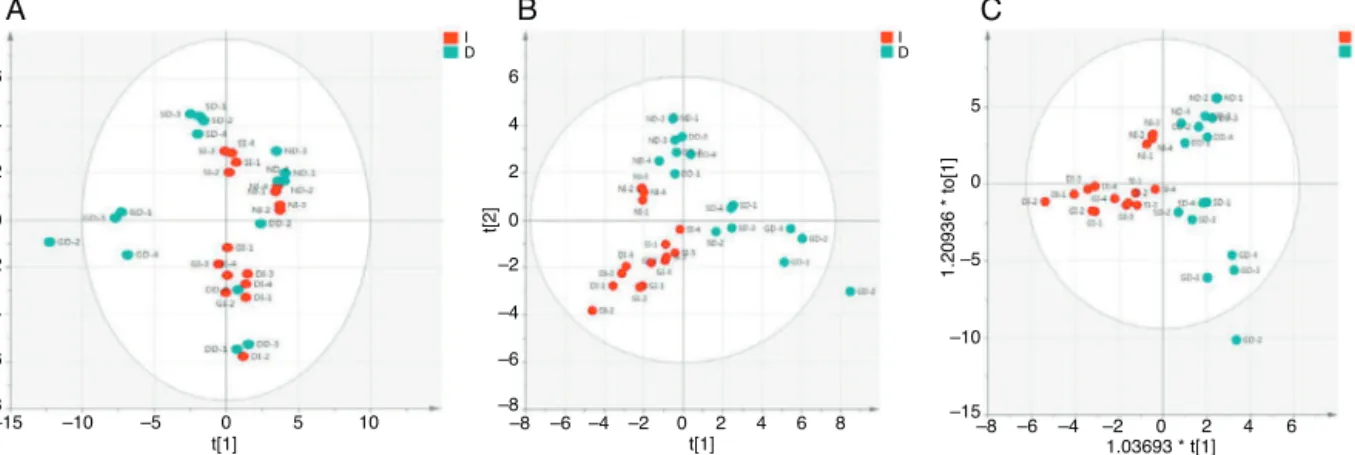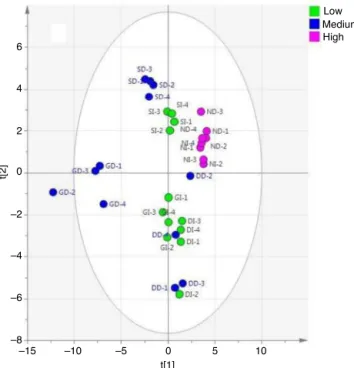RevistaBrasileiradeFarmacognosia27(2017)580–586
w ww.e l s e v i e r . c o m / l o c a t e / b j p
Original
Article
GC–MS
based
metabolite
profiling
and
angiotensin
I-converting
enzyme
inhibitory
property
of
black
tea
extracts
Sonali
Ray
a,
Mainak
Dutta
b,
Koel
Chaudhury
b,
Bratati
De
a,∗aPhytochemistryandPharmacognosyResearchLaboratory,DepartmentofBotany,CentreofAdvancedStudies,UniversityofCalcutta,Calcutta,India bSchoolofMedicalScienceandTechnology,IndianInstituteofTechnology,Kharagpur,India
a
r
t
i
c
l
e
i
n
f
o
Articlehistory:
Received13January2017
Accepted26May2017
Availableonline24July2017
Keywords:
Blacktea
AngiotensinI-convertingenzyme
Metabolites Metabolomics
a
b
s
t
r
a
c
t
AngiotensinI-convertingenzymeinhibitorsareusedastherapeuticagentsforthetreatmentof hyper-tension.Regularconsumptionofblacktea(Camelliasinensis(L.)Kuntze,Theaceae)hasbeenreported tolowerbloodpressure.Theaimsofthepresentworkweretocomparechemicalcompositionand angiotensinI-convertingenzymeinhibitorypropertiesofinfusionanddecoctionoffoursamplesofblack tea.GC/MSbasedmetabolomicsapproachhelpedinidentificationoffifty-onemetabolitesincludingten organicacids,oneinorganicacid,sixteenaminoacids,twosugars,fivesugaralcohols,fifteenphenols andflavonoids,twofattyacidsfrominfusionsanddecoctionsoffourblackteasamples.Partialleast squaresdiscriminantanalysisandorthogonalpartialleastsquaresdiscriminantanalysismodelsshowed goodclassificationamongthetwogroups,diffusionandinfusion,basedonmetabolites.Bothinfusion anddecoctioninhibitedtheenzyme.However,theactivitydifferedwithsamples.Multivariateanalysis alsosegregatedextractsonthebasisofactivity.Thearubigin,theaflavin,catechininhibitedtheenzyme. Epicatechin,epigallocatechingallate,gallicacid,caffeineshowedloweractivity.
©2017SociedadeBrasileiradeFarmacognosia.PublishedbyElsevierEditoraLtda.Thisisanopen accessarticleundertheCCBY-NC-NDlicense(http://creativecommons.org/licenses/by-nc-nd/4.0/).
Introduction
Tea,producedfromthetoptwofreshgreenleavesandabudof
Camelliasinensis(L.)Kuntze,Theaceae,isoneofthemostfrequently
consumedbeverages intheworld.Teais generallyclassifiedas
blacktea,greentea,oolongteaandwhiteteadependingonthe
degreeof maceration of leafcells and fermentation duringthe
manufacturingprocess(HilalandEngelhardt,2007).Blacktea(BT)
accountsfor72%oftheworld’stotalteaproduction(Ngetal.,2008).
MedicinalandtherapeuticpotentialofBT(Sharangi,2009)iswell
known.
AngiotensinI-Converting Enzyme(ACE) is a key component
intherenin angiotensin aldosteronesystem(RAAS)(Balasuriya
andRupasinghe,2011)which convertsinactiveangiotensinIto
angiotensinII,apowerfulvasoconstrictorandpromoterofsodium
retention, and inactivates vasodilator bradykinin which is
con-ducivetolowerblood pressure(JohnstonandFranz,1992).One
ofthereasonsofthepathogenesis ofhypertension isincreased
activity of RAAS (Balasuriya and Rupasinghe, 2011). In many
cardiovasculardiseases, angiotensin IIis present in abnormally
∗ Correspondingauthor.
E-mail:bdbot@caluniv.ac.in(B.De).
highquantities. Blockingproduction of angiotensinIIwithACE
inhibitors prevents constriction of blood vessels, lowers blood
pressure (Sweitzer, 2003). ACE inhibitors were developed as
therapeutic agents for the treatment of hypertension (Brown
and Vaughan, 1998). Several ACE inhibitors such as captopril,
enalapril,lisinoprilandtemocaprilareinclinicaluseforthe
treat-ment ofhypertension. Allofthese drugsproduced side effects,
thus justifying the search for natural ACE inhibitors for safe
and economical use (Coates, 2003). Therefore, ACE inhibitors
from natural sources, particularly dietary sources, are
poten-tiallybeneficial.Differentplantbasedfoods(Miccueetal.,2005;
Oboh et al., 2012; Das and De, 2013; Acharya et al., 2016),
otherplants (Braga et al., 2007), phenolic rich extracts of
soy-bean (Ademiluyi and Oboh, 2013) and several phytochemicals
suchasisoquercetin,apigenin,luteolin, glycosidesof quercetin,
cyanidin,kaempferol, luleolin (Loizzo et al.,2007; Junioret al.,
2011;BalasuriyaandRupasinghe,2011)werereportedtoinhibit ACE.
Regularconsumptionofblackteahasbeenreportedtolower
bloodpressure(Hodgsonetal.,2012).InvitroACEinhibitory
activ-itywasaffectedbytheteaprocessingmethodwithIC50 values
forACEinhibition:green<oolong<white<black<darkteas.The
reportsuggestedthattheteapolyphenolicsexertamixedmode
ofinvitroinhibitionofACE(Dongetal.,2011).
http://dx.doi.org/10.1016/j.bjp.2017.05.006
0102-695X/©2017SociedadeBrasileiradeFarmacognosia.PublishedbyElsevierEditoraLtda.ThisisanopenaccessarticleundertheCCBY-NC-NDlicense(http://
S.Rayetal./RevistaBrasileiradeFarmacognosia27(2017)580–586 581
InIndiablackteaisconsumedeitherasinfusionorasdecoction
(Rayetal.,2014).Theaimsofthepresentworkweretocompare
chemicalcompositionandACEinhibitorypropertiesofinfusions
anddecoctionsofdifferentsamplesofblacktea.
Materialsandmethods
Plantmaterials
Fourblacktea–Camelliasinensis(L.)Kuntze,Theaceae–(BT)
samples(Doorstea,Siliguritea,GuwahatiteaandNilgiritea)(CTC,
firstflush)werecollectedin2006fromDuncansTeaLtd.,Kolkata,
Indiawhoarehavingtheirownteagardensandtheyarealsoin
packagedteabusinessforretailconsumerswhereteaiscollected
fromdifferentsources.ThesampleswereidentifiedbyB.Deand
areavailableinthelaboratory.
Reagents
Theaflavin [80% theaflavins (theaflavin and
theaflavingal-lates)], angiotensin converting enzyme from rabbit lung,
hippuryl-l-histydyl-l-leucine (HHL), catechin, epicatechin,
epigallocatechingallate,methoxyaminehydrochloride,
N-methyl-N-trimethylsilyltrifluoroacetamide (MSTFA), methyl octanoate
(C8),methyldecanoate(C10),methyllaurate(C12),myristicacid
methylester (C14),methylpalmitate(C16),stearic acidmethyl
ester (C18), methyl arachidate (C20), methyl behenate (C22),
methyltetracosanoate(C24), methylhexacosanoate(C26)were
purchasedfromSigma–Aldrich(St.Louis,MO);gallicacid,caffeine,
fromSiscoResearchLaboratoriesPvt.Ltd.,India.Allthesolvents
used for GC/MS were of HPLC grade. Other reagents were of
analyticalgrade.
Preparationofextract
Infusionof teawaspreparedby soakingtealeaves(20g) in
boileddistilledwater(170ml)for5min.Theaqueousfiltratewas
evaporatedtodryness underreduced pressure.Decoction oftea
waspreparedbyboilingtealeaves(20g)indistilledwater(170ml)
for5min.Theaqueousextractwasfilteredandevaporatedto
dry-ness.ThedriedinfusionanddecoctionofBTwasstoredat−20◦C.
Preparationofthearubigin
Thearubigin(TR)wasisolatedfromBTfollowingthepreviously
reportedmethod(Misraetal.,2003).BT(6g)wasboiledin50ml
sodiumacetate(10mM,pH5.0)for10min,cooledandfiltered.The
filtratewasextractedsuccessivelywithequalvolumesof
chloro-form,methylisobutylketoneandethylacetate.Theorganiclayers
werediscardedandtheaqueouslayerwasextractedwithbutanol
followedbylyophilization.Theresidualdarkorangepowder
con-stitutedtheTR.
GC–MSanalysis
CrudeBTextractwasderivatizedandanalyzedbyGC–MS
fol-lowingthepreviouslyreportedmethod(Dasetal.,2016;Karak
etal.,2017).Briefly, BTextractand adonitol(internalstandard)
dissolvedinMeOH:H2O(1:1)wasdistributedintoEppendorftubes
(4×50l)andevaporatedtodryness.Theresiduewasre-dissolved
in10lofmethoxyaminehydrochloride(20mg/mlinpyridine)
and subsequently shakenfor90minat 30◦C and then 90lof
N-methyl-N-trimethylsilyltrifluoroacetamide(MSTFA)wasadded
andshakenat37◦Cfor30minfortrimethylsilylationofacidic
pro-tonstoincrease volatility of metabolites. 2lFAME (fatty acid
methyl esters) markers (a mixture of internal retention index
(RI)markers)dissolvedinchloroformwasadded.GC–MS
analy-sis(Agilent5975CGasChromatographySystem)wascarriedout
in HP-5MScapillarycolumn (AgilentJ&W; GC Columns,USA)
(length30mplusDuraguard10m,diameter0.25mmnarrowbore,
film0.25m). Theanalysiswasperformedunderthefollowing
oventemperatureprogramme:ovenramp 60◦C (1minhold) to
325◦Cat10◦C/min,10minholdbeforecool–down,37.5minrun
time.Theinjectiontemperaturewassetat250◦C;theMS
trans-ferlineat290◦Candtheionsourceat230◦C.Heliumwasusedas
thecarriergasataconstantflowrateof0.723ml/min(carrier
lin-earvelocity31.141cm/s).Sample(1l)wasinjectedviathesplit
mode(splitratio1:5)ontotheGCcolumn.Automatedmass
spec-traldeconvolutionandidentificationsystem(AMDIS)wasusedto
deconvoluteGC–MSresultsandtoidentifychromatographicpeaks.
Identificationofthemetaboliteswascarriedoutbycomparingthe
fragmentationpatternsofthemassspectraandretentiontimes
(Rt)withthosepresentinAgilentFiehnMetabolomicslibraryusing
Agilentretentiontimelocking(RTL)method.
Assayofangiotensinconvertingenzyme
Angiotensinconvertingenzyme(ACE)inhibitoryactivitywas
measuredfollowingthespectrophotometricassay(Cushmanand
Cheung,1971)withmodifications.Aqueousteaextract(15l)/its
component(37M)wasincubatedwith250lof200mMborate
buffer(pH.8.3)containing2MNaCland7mM
hippuryl-histidyl-leucine(HHL).ACEfromrabbitlung,(100mU)(15l)anddistilled
water (20l) were added and the reaction mixture was
incu-bated at 37◦C for 30min. The reaction was stopped with 1N
HCl(250l).Thehippuricacidformedwasextractedwithethyl
acetate(1500l).Afterremovalofethylacetate(1000l)by
evap-oration, hippuricacidwasdissolvedin500lof distilledwater
and measured spectrophotometrically at 228nm. The activity
of each sample was tested in triplicate. The percentage
inhi-bition of ACE activity by teaextract and its components were
calculated.
Statisticalanalysis
Multivariateanalysiswasperformedonthenormalizeddata
setusingSIMCAsoftware.Groupswereformedbasedbyactivity,
infusionanddecoction.Unsupervisedmodelsuchasprincipal
com-ponentanalysis(PCA)andsupervisedmodelssuchasorthogonal
partialleastsquarediscriminantanalysis(OPLS-DA)were
gener-ated.R2(goodness-of-fit)andQ2(goodness-of-prediction)values
wereextractedforvalidationofthesemodels.
Resultsanddiscussion
Analysisofchemicalcomposition
Differentgroupsofchemicalconstituentshavepreviouslybeen
reportedfromBT. Theyinclude alkaloids(Hilaland Engelhardt,
2007), hydrolysable tannins, simple phenols and derivatives
(Sakamotoetal.,2012;Ramalhoetal.,2013),catechins,theaflavins
(HilalandEngelhardt,2007;Lietal.,2013),thearubigins(Drynan
et al., 2010), otherflavonols and glycosides (Degenhardt et al., 2000),amino acids(Alcazaretal.,2007; Sakamotoetal.,2012)
and volatile and non-polar constituents (Sereshti et al., 2013;
Wang et al., 2011). Thearubigins are complex in nature.
Esti-mated 60% of the solids in BT infusion are thearubigins, with
more than 5000 individual chemical entities (Kuhnert, 2010).
In ourpreviouswork, wereported presence ofgallic acid,
cat-echin, epicatechin, epicatechingallate, epigallocatechin gallate,
theaflavin, theaflavin-3-monogallate, theaflavin-3′-monogallate,
582
S.
Ray
et
al.
/
Revista
Brasileira
de
Farmacognosia
27
(2017)
580–586
Table1
MetabolitesdetectedinBTextracts.
Metabolites Doors Guahati Siliguri Nilgiri
Infusion Decoction Infusion Decoction Infusion Decoction Infusion Decoction
Organicacids
l-(+)Lacticacid 68.68±11.56 32.49±9.73 11.68±2.85 2.91±4.49 19.71±0.94 13.40±2.04 12.19±2.20 8.52±0.80
Fumaricacid 0.37±0.19 0.57±0.20 0.19±0.21 0.25±0.21 0.21±0.16 tr tr tr
Gluconicacid 0.66±0.68 2.30±2.76 2.26±0.06 tr tr tr tr tr
Glycericacid 17.50±4.14 19.94±5.39 7.77±0.85 17.15±4.10 14.61±1.38 15.08±0.71 24.88±4.57 24.36±2.64
Glycolicacid 5.92±1.14 2.43±0.91 1.81±0.62 3.53±0.87 2.14±0.12 1.68±0.16 4.94±1.00 1.92±0.19
d-Malicacid 37.51±8.82 90.36±31.62 39.87±21.71 59.15±32.95 132.71±21.54 115.12±21.57 68.56±16.71 93.09±13.09
Malonicacid 8.21±1.62 5.26±2.75 4.74±0.52 2.63±0.48 2.72±0.86 1.36±0.32 4.03±1.10 2.29±0.32
Oxalicacid 2.59±0.96 0.61±0.76 0.00±0.00 8.08±6.67 3.37±2.59 2.16±1.60 tr tr
Succinicacid 39.53±15.03 22.24±7.73 15.93±1.40 21.93±2.14 25.49±0.57 22.45±0.38 35.39±3.57 27.38±1.31
Gluconicacid
lactone
tr tr tr 3.07±0.76 tr tr tr 388.87±763.51
Inorganicacid
Phosphoricacid 49.84±16.35 583.13±354.38 148.83±115.44 266.47±51.82 153.61±29.13 125.66±34.09 37.44±14.24 43.89±9.66
Aminoacids
l-Alanine 0.77±0.78 tr 2.36±0.62 1.76±1.03 0.51±1.03 2.02±1.62 tr tr
Beta-alanine 0.15±0.10 0.38±0.26 0.31±0.62 tr tr tr 0.31±0.23 tr
l-Allothreonine 1.25±1.50 2.98±1.05 3.41±1.05 tr 2.80±3.27 1.51±3.02 tr tr
l-Asparagine tr tr 5.95±1.04 6.45±1.64 17.70±3.60 19.48±1.67 tr tr
Asparticacid tr 2.82±1.14 7.64±1.55 30.30±41.57 9.35±1.18 14.25±10.32 tr tr
Glutamicacid tr 1.02±2.04 1.73±3.47 27.25±11.33 18.22±2.28 22.89±2.04 tr tr
l-Glutamine tr tr 2.20±1.14 4.18±1.54 1.56±0.10 1.70±1.13 tr tr
l-Leucine 3.65±0.70 1.58±0.56 2.71±0.20 5.81±1.13 1.32±0.88 0.77±0.90 tr tr
dl-Isoleucine 8.77±1.58 3.99±1.01 5.95±0.42 11.48±3.62 3.70±1.61 3.52±1.47 tr tr
l-Proline 0.40±0.40 0.14±0.29 0.15±0.29 0.91±1.06 tr 0.40±0.79 tr tr
l-Pyroglutamic
acid
123.55±42.72 146.79±69.97 120.83±24.72 642.04±68.31 75.53±14.28 77.49±12.23 42.89±6.41 32.12±2.91
l-Serine 0.81±0.48 2.15±0.77 3.60±0.70 11.48±2.31 5.40±0.76 5.88±0.79 tr tr
l-Threonine 1.73±1.36 tr tr 8.31±5.78 5.13±0.90 4.90±3.27 tr tr
l-Tryptophan 6.09±3.99 2.91±5.81 14.86±4.17 20.50±1.91 tr 7.70±1.09 tr tr
l-Tyrosine 27.61±4.15 21.73±6.31 43.47±7.51 71.82±10.99 6.82±1.37 8.87±0.42 4.20±4.87 4.14±4.83
S.
Ray
et
al.
/
Revista
Brasileira
de
Farmacognosia
27
(2017)
580–586
583
Table1(Continued)
Metabolites Doors Guahati Siliguri Nilgiri
Infusion Decoction Infusion Decoction Infusion Decoction Infusion Decoction
Sugaralcohols
Arabitol tr 3.38±4.26 2.87±1.89 8.22±2.29 tr tr tr tr
Glycerol 486.52±251.43 863.78±234.19 145.76±20.03 249.33±110.46 81.66±12.60 89.34±31.07 504.11±54.64 526.95±33.76
Glycerol 1-phosphate
4.56±1.09 16.09±5.80 6.30±0.50 18.05±2.92 3.52±0.46 4.64±0.22 4.66±1.71 4.03±0.40
d-Threitol 0.50±0.55 14.22±27.88 0.83±0.21 4.64±6.46 4.16±5.84 3.85±5.41 0.26±0.20 37.51±35.28
d-Mannitol 7.35±3.43 9.52±2.51 6.74±1.18 8.52±1.75 6.36±0.42 3.98±4.08 4.75±0.54 4.58±2.12
Sugars
Sucrose tr 1049.03±774.86 466.86±932.48 2445.48±1634.37 2755.59±2041.10 5280.73±3549.56 732.48±1464.95 3263.53±133.55
Raffinose 15.29±5.74 19.55±5.34 28.08±5.97 tr tr tr 15.72±10.60 14.13±9.44
Phenols
O-Acetylsalicylic acid
1.93±1.26 tr 1.32±1.09 4.90±4.40 3.82±0.70 6.16±3.55 1.63±1.26 tr
Arbutin 2.11±1.21 0.55±0.64 1.17±0.89 1.48±0.85 tr tr 1.28±0.69
Caffeicacid 0.52±0.07 0.40±0.34 0.25±0.08 0.37±0.27 tr tr tr tr
Catechin 5.40±4.82 9.43±7.76 9.71±6.53 43.75±16.68 12.16±0.30 27.59±18.44 4.14±0.68 4.31±0.09
Chlorogenicacid 6.10±0.33 10.71±8.00 4.84±0.28 13.95±2.22 7.69±0.48 13.84±0.86 5.02±1.07 4.30±0.20
Epicatechin 1.97±0.33 1.60±0.41 3.02±0.60 7.49±1.09 1.02±0.32 2.97±0.08 2.59±0.21 2.80±0.08
(−)-Epicatechin 12.28±3.49 29.03±14.00 33.52±5.01 220.42±143.50 39.87±1.66 168.15±91.11 19.80±1.45 24.06±1.14
Epigallocatechin 87.69±26.10 123.68±62.68 57.31±6.47 275.26±186.45 56.87±2.92 224.58±184.49 60.39±3.86 66.34±2.23
Gallicacid 1320.15±174.24 1756.13±507.26 1621.10±803.53 1780.27±554.01 1959.65±146.45 2753.12±370.97 1944.48±295.29 1623.29±2048.25
4-Hydroxybenzoic acid
tr tr tr 0.61±0.44 tr tr 0.61±0.46 0.63±0.06
3,4-Dihydroxybenoic acid
22.65±23.19 27.81±22.03 6.74±7.83 30.10±22.20 6.63±2.01 5.84±3.96 41.95±4.50 40.17±5.82
Phloroglucinol 1.06±0.15 3.15±0.48 4.24±7.11 5.06±4.44 0.49±0.21 3.36±0.90 1.45±0.17 4.40±2.94
Pyrogallol 0.23±0.39 0.79±1.00 tr 2.26±3.70 0.28±0.37 0.40±0.79 tr tr
Quinicacid 1518.37±487.66 3193.93±2541.39 3018.06±2413.46 2145.28±513.79 2734.01±2143.35 4713.67±3862.05 3764.45±1895.25 1515.46±776.09
Shikimicacid 551.79±44.49 527.83±159.88 578.36±54.13 1096.42±143.20 530.10±16.82 633.49±92.33 409.00±33.89 283.96±20.31
Fattyacids
Palmiticacid 5.43±1.92 10.94±4.53 13.17±6.46 4.70±1.04 3.52±0.82 2.90±0.64 2.35±0.65 2.18±0.28
Stearicacid 6.14±2.09 19.41±8.15 22.11±14.68 tr tr 1.37±2.73 4.32±0.60 3.27±0.82
584 S.Rayetal./RevistaBrasileiradeFarmacognosia27(2017)580–586
A
6
4
2
0
–2
–4
–6
–8
6
4 5
0
–5
–10
–15 2
0
–2
–4
–6
–8
–15 –10 –5 0
t[1] t[1] 1.03693 * t[1]
1.20936 * to[1]
t[2] t[2]
5
I
D ID ID
10 –8 –6 –4 –2 0 2 4 6 8 –8 –6 –4 –2 0 2 4 6
B
C
Fig.1.MultivariateanalysessegregatingBTinfusionsanddecoctionsonthebasisofmetabolites.(A)PCAscoreplot;(B)PLS-DAscoreplot;(C)OPLS-DAscoreplot.I,infusion;
D,decoction;DD,doorsdecoction;DI,doorsinfusion;GD,Guwahatidecoction;GI,Guwahatiinfusion;ND,Nilgiridecoction;NI,Nilgiriinfusion;SD,Siliguridecoction;SI,
Siliguriinfusion.
BTextractsanalyzedbyHPLC(Rayetal.,2014).Duringthepresent
work the metabolite profile of infusion and decoction of four
samplesofBTwerecomparedusingGC–MSbasedmetabolomics
approachtoidentifymorecompoundspresentinteaextracts.The
metabolomicstechnologyhelpedtoidentifyfiftyonecomponents
includingtenorganicacids,oneinorganicacid,sixteenaminoacids,
twosugarsandfivesugaralcohols,fifteenphenolsandflavonoids,
twofattyacids(Table1).Presentanalysisdetectedphenolslike
O-acetylsalicylicacid,arbutin,caffeicacid,4-hydroxybenzoicacid,
phloroglucinol,quinicacid,shikimicacidandsomesugarswhich
werenotreportedearlier,tothebestofourknowledge.However,
some compounds e.g. different theaflavins identified earlier by
HPLC method(Ray et al.,2014) couldnot be identified bythe
methodusedduringthepresentlibraryassistedGC–MSanalysis.
Thedatapresented inTable1 arenormalizedrelative response
ratios calculated by dividing peak areas of the metabolites by
sampleweightandbypeakareaoftheinternalstandard.Thedata
were analyzed by different multivariate analyses PCA, PLS-DA
and OPLS-DA.PLS-DA and OPLS-DA (Fig. 1a–c) modelsshowed
good segregationamong groups, decoctionand infusion,based
onmetabolites.Thefindings suggestthat theteasampleswere
differentonthebasisofidentifiedmetabolites.
120
100
80
60
40
20
0
Dooars
% Inhibition
19.94
±
3.33
18.56
±
3.12
26.22
±
1.87
51.08
±
3.26
66.05
±
6.62
87.29
±
3.23 100
±
8.1
1
Infusion Decoction Mixture Authentic
64.93
±
1.96
57.5
±
1.71
6.01
±
3.23
27.95
±
1.01
49.12
±
0.06
14.58
±
1.32 25.93
±
10.21
100
±
1.1
1
54.59
±
4.81
Guwahati
Siliguri Nilgiri
Thearubigin Theaflavin
Caf
feine
Gallic acid Catechin
Epicatechin
Epigallocatechin gallate
Lisinopril
S.Rayetal./RevistaBrasileiradeFarmacognosia27(2017)580–586 585
6
4
2
0
–2
–4
–6
–8
–15 –10 –5 0 t[1]
t[2]
5 10
Low Medium High
Fig.3.PCAscoreplotseparatingBTinfusionsanddecoctionsonthebasisofACE
inhibitionactivity.DD,doorsdecoction;DI,doorsinfusion;GD,Guwahati
decoc-tion;GI,Guwahatiinfusion;ND,Nilgiridecoction;NI,Nilgiriinfusion;SD,Siliguri
decoction;SI,Siliguriinfusion.
Angiotensinconvertingenzymeinhibitoryactivity
ACEinhibitoryactivityofBTinfusions,BTdecoctionswere
com-paredat15g/mlconcentration.Amongalltheteasamples,Nilgiri
infusionanddecoctionexhibitedhighestactivities(87%inhibition
byinfusionand100%inhibitionbydecoction).Lisinopril(37M)
exhibited100%inhibition.Butotherteaextractshadactivitylower
thanthatofLisinopril(Fig.2).Nilgirisamplesshowednosignificant
differencesinactivitybetweeninfusionanddecoctions.However,
intheotherthreesamples,activitiesofdecoctionswerehigherthan
theinfusions.PCA(Fig.3)modelshowedgoodclassificationamong
groupsbasedonactivity.ThissuggestedthattheACEinhibitory
activityofBTinfusionsanddecoctionsweredifferent.Afew
iden-tifiedmetabolites,availableinthelaboratory,weretestedforthe
ACEinhibitorypropertiesat37Mconcentration.Thearubiginis
acomplexmixture(Kuhnert,2010).Procuredtheaflavinwasalso
a mixture of theaflavin and theaflavingallates. So theactivities
ofthesetwocompoundsweretestedat15g/mlconcentration.
Thearubigin,andtheaflavin inhibitedtheenzyme bymorethan
50%.Noneoftheauthenticphenolsandflavonoidsinhibitedthe
enzymemorethan50%.Amongsttheauthenticcompounds,
cate-chinshowedhighestactivity.Thealkaloidcaffeinealsoinhibited
theenzyme,althoughtheactivityofthiscompoundwasfoundto
belowest(Fig.2).Lisinopril(37M),oneofthemostwidelyused
ACEinhibitor(Nateshetal.,2003),inhibited100%enzyme
activ-ity.Previously,extractsofgreentea,blacktea,rooibosteaandalso
themainflavanolsandpurinealkaloidsingreenandblackteawere
examinedfortheireffectsonACEinculturedendothelialcellsfrom
humanumbilicalveins(HUVEC).Greentea,blackteaandrooibos
teaexhibiteddose-dependentinhibitionofACEactivityinHUVEC.
(−)-Epicatechin,(−)-epigallocatechin,(−)-epicatechingallateand
(−)-epigallocatechingallatealsoinhibitedACEactivityinHUVEC
(Perssonetal.,2006).Thepresentstudyshowsthatthearubigin,
theaflavin,catechinhadsignificantlyhigheractivitythanthoseof
epicatechinandepigallocatechingallate.Thus thepresentstudy
suggeststhatBTmayhavebeneficialeffectinloweringblood
pres-surebecauseofACEinhibitoryproperties.
Althoughnotcalculated,itisobviousthatthequantityofeach
ofthesecomponentsweremuchlowerinthecrudeextractoftea
atthisconcentration(15g/ml).Thus,fromtheabove
chemomet-ricfindingsandthecomparison ofactivitiesof teaextractsand
some flavonoids and caffeine, it couldbe inferred that the tea
components have either additive or synergistic activities for
inhibiting ACE. Such synergistic activities have recently been
published(Colonand Nerin,2016)forDPPH radicalscavenging
activitiesingreentea.
Conclusion
Infusionsanddecoctionsobtainedfromfourdifferentsamples
of black tea were analyzed for metabolites and ACE inhibition
properties.Theinfusionsandthedecoctionswerefoundtobe
dif-ferentonthebasisofmetabolitelevel.Alltheextractsinhibitedthe
enzymeACE.Nilgiridecoctionshowedactivitysimilartothatofthe
drugLisinopril.Ofthefiftyonedifferentmetabolitesidentifiedby
GC–MS,thearubigin,theaflavin,catechin,gallicacid,epicatechin
andepigallocatechingallate,caffeineinhibitedACEthefirstthree
showinghigheractivitythantheothers.
Authors’contributions
SRperformedexperiments.MDandKCdidstatisticalanalysis
andinterpretationofresults.BDprovidedidea,projectplan.Allthe
authorswereinvolvedinthepreparationofthemanuscript.
Conflictsofinterest
Theauthorsdeclarenoconflictsofinterest.
Acknowledgements
FinancialsupportfromDST(FIST)andUniversityGrant
Com-mission,Indiaisgratefullyacknowledged.
References
Acharya, J., Karak, S., De, B., 2016. Metabolite profile and bioactivity of
Musa×paradisiacaL.flowerextracts.J.FoodBiochem.40,724–730.
Ademiluyi,A.O.,Oboh,G.,2013.Soybeanphenolicrichextractsinhibitkeyenzymes
linkedtotype2diabetes(␣-amylaseand␣-glucosidase)andhypertension (angiotensinIconvertingenzyme)invitro.Exp.Toxicol.Pathol.65,305–309.
Alcazar,A.,Ballesteros,O.,Jurado,J.M.,Pablos,F.,Martin,M.J.,Vilches,J.L.,Navalon,
A.,2007.Differentiationofgreen,white,black,oolongandpu-erhteasaccording
totheirfreeaminoacidcontents.J.Agric.FoodChem.55,5960–5965.
Balasuriya,B.W.N.,Rupasinghe,H.P.V.,2011.Plantflavonoidsasangiotensin
con-vertingenzymeinhibitorsinregulationofhypertension.Funct.FoodsHealth Dis.5,172–188.
Braga,F.C.,Serra,C.P.,Junior,N.S.V.,Oliviera,A.B.,Cortes,S.F.,Lombardi,J.A.,2007.
Angiotensin-convertingenzymeinhibitionbyBrazilianplants.Fitoterapia78, 353–358.
Brown,N.J.,Vaughan,D.E.,1998.Angiotensin-convertingenzymeinhibitors.
Circu-lation97,1411–1420.
Coates,D.,2003.Theangiotensinconvertingenzyme(ACE).Int.J.Biochem.Cell.Biol.
35,769–773.
Colon,M.,Nerin,C.,2016.Synergistic,antagonisticandadditiveinteractionsofgreen
teapolyphenols.Eur.FoodRes.Technol.242,211–220.
Cushman,D.W.,Cheung,H.S.,1971.Spectrophotometricassayandpropertiesof
theangiotensinI-convertingenzymeofrabbitlung.Biochem.Pharmacol.20, 1637–1648.
Das,S.,De,B.,2013.EvaluationofangiotensinI-convertingenzyme(ACE)inhibitory
potentialofsomeunderutilizedfruitsofWestBengalusinganinvitromodel. Fruits68,499–506.
Das,S.,Dutta,M.,Chaudhury,K.,De,B.,2016.Metabolomicandchemometricstudy
ofAchrassapotaL.fruitextractsforidentificationofmetabolitescontributing totheinhibitionof␣-amylaseand␣-glucosidase.Eur.FoodRes.Technol.242, 733–743.
Degenhardt,A.,Engelhardt,H.U.,Lakenbrink,C.,Winterhalter,P.,2000.Preparative
586 S.Rayetal./RevistaBrasileiradeFarmacognosia27(2017)580–586
Dong,J.,Xu,X.,Liang,Y.,Head,R.,Bennett,L.,2011.Inhibitionofangiotensin
con-vertingenzyme(ACE)activitybypolyphenolsfromtea(Camelliasinensis)and linkstoprocessingmethod.FoodFunct.2,310–319.
Drynan,J.W.,Clifford,M.N.,Obuchowicz,J.,Kuhnert,N.,2010.Thechemistryoflow
molecularweightblackteapolyphenols.Nat.Prod.Rep.27,417–462.
Hilal,Y.,Engelhardt,U.,2007.Characterisationofwhitetea–comparisontogreen
andblacktea.J.Verbr.Lebensm.2,414–421.
Hodgson,J.M.,Puddey,I.B.,Woodman,R.J.,Mulder,T.P.J.,Fuchs,D.,Scott,K.,Croft,
K.D.,2012.Effectsofblackteaonbloodpressure:arandomizedcontrolledtrial.
Arch.Intern.Med.172,186–188.
Johnston,J.I.,Franz,V.,1992.Renin–angiotensinsystem:adualtissueandhormonal
systemforcardiovascularcontrol.J.Hypertens.10,13–26.
Junior, A.G.,Gasparroto, F.M., Lourenco, E.L.B., Crestani, S.,Stefanello, M.E.A.,
Salvador,M.J.,daSilva-Santos,J.E.,Marques,M.C.A.,Kassuya,C.A.L.,2011.
Anti-hypertensiveeffectsfromTropeolummajusL.:evidencefortheinhibitionof angiotensinconvertingenzyme.J.Ethnopharmacol.134,363–372.
Karak,S.,Nag,G.,De,B.,2017.Metabolicprofileand-glucuronidaseinhibitory
propertyofthreespeciesofSwertia.Rev.Bras.Farmacogn.27,105–111.
Kuhnert,N.,2010.Unravellingthestructureoftheblackteathearubigins.Arch.
Biochem.Biophys.501,37–51.
Li,S.,Lo,C.Y.,Pan,M.H.,Lai,C.S.,Ho,C.T.,2013.Blacktea:chemicalanalysisand
stability.FoodFunct.4,10–18.
Loizzo,M.P.,Said,A.,Tundis,R.,Rashed,K.,Statti,G.A.,Hufner,A.,Menichini,F.,2007.
Inhibitionofangiotensinconvertingenzyme(ACE)byflavonoidsisolatedfrom Ailanthusexcelsa(Roxb.)(Simaroubacea).Phytoter.Res.21,32–36.
Miccue,P.,Kwon,Y.,Shetty,K.,2005.Anti-amylase,anti-glucosidaseand
anti-angiotensinI-convertingenzymepotentialofselectedfood.J.FoodBiochem. 29,278–294.
Misra,A.,Chattopadhyay,R.,Banerjee,S.,Chattopadhyay,D.J.,Chatterjee,I.B.,2003.
Blackteapreventscigarettesmokeinducedoxidativedamageofproteinsin guineapigs.J.Nutr.133,2622–2628.
Natesh,R.,Schwager,S.L.U.,Sturrock,E.D.,Acharya,K.R.,2003.Crystalstructure
ofthehumanangiotensin-convertingenzyme-lisinoprilcomplex.Nature421, 551–554.
Ng,T., Feng, L.,Niti,M., Kua,E., Yap,K., 2008.Tea consumption and
cogni-tiveimpairmentanddeclineinolderChineseadults.Am.J.Clin.Nutr.88, 224–231.
Oboh,G.,Ademiluyi,A.O.,Akinyemi,A.J.,Heule,T.,Salice,J.A.,Schwarzenbolz,U.,
2012.Inhibitoryeffectofpolyphenol-richextractsofjuteleaf
(Corchorusolito-rius)onkeyenzymeslinkedtotype2diabetes(␣-amylaseand␣-glucosidase) and hypertension (angiotensin I converting) in vitro. J. Funct. Foods 4, 450–458.
Persson, I.A., Josefsson,M., Persson, K., Andersson, R.G., 2006. Tea flavonols
inhibit angiotensin-converting enzyme activity and increase nitric oxide production in human endothelial cells. J. Pharm. Pharmacol. 58, 1139–1144.
Ramalho,S.A.,Nigam,N.,Oliveira,G.B.,deOliveira,P.A.,Silva,T.O.M.,dosSantos,
A.G.P.,Narain,N.,2013.Effectofinfusiontimeonphenoliccompoundsand
caffeinecontentinblacktea.FoodRes.Int.51,155–161.
Ray,S.,Samanta,T.,Mitra,A.,De,B.,2014.Effectofextractsandcomponentsof
blackteaontheactivityof-glucuronidase,lipase,␣-amylase,␣-glucosidase: aninvitrostudy.Curr.Nutr.FoodSci.10,181–186.
Sakamoto,A.,Inoue,H.,Nakagawa,M.,2012.Contentofchemicalconstituents
of 12 kinds of black tea. Nippon Shokuhin Kagaku KogakuKaishi 59, 326–330.
Sereshti,H.,Samadi,S.,Jalali-Heravi,M.,2013.Determinationofvolatile
compo-nentsofgreen,black,oolongandwhiteteabyoptimizedultrasound-assisted extraction-dispersiveliquid-liquid microextractioncoupled with gas chro-matography.J.Chromatogr.A1280,1–8.
Sharangi,A.B.,2009.Medicinalandtherapeuticpotentialitiesoftea(Camelliasinensis
L.)–areview.FoodRes.Int.42,529–535.
Sweitzer,N.K.,2003.Whatisanangiotensionconvertingenzymeinhibitor?
Circu-lation108,e16–e18.
Wang,K.,Liu,F.,Liu,Z.,Huang,J.,Xu,Z.,Li,Y.,Chen,J.,Gong,Y.,Yang,X.,2011.

